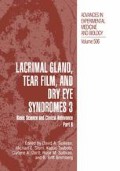Abstract
Dry eye patients have been divided primarily into two categories, evaporative or tear production-deficient.1 In both cases, increased tear evaporation and by extension, evaporation rate, is a significant parameter in the etiology and pathogenesis of dry eye. Paradoxically, the use of tear supplements has been shown to exacerbate tear evaporative loss.2 Theoretically, tear supplements should cause minimal increases in evaporation and ideally, should reduce evaporation of the tear film.
Access this chapter
Tax calculation will be finalised at checkout
Purchases are for personal use only
Preview
Unable to display preview. Download preview PDF.
References
Lemp MA. Report of the NEI/Industry Workshop on clinical trials in dry eyes. CLAO J 1995, 21:221
Trees G, Tomlinson A. Effects of artificial tear solutions and saline on the tear film evaporation. Optom Vis Sci, 1990, 67:886
Stevenson D, Tauber J, Reis BL. Efficacy and safety of cyclosporin A ophthalmic emulsion in the treatment of moderate-to-severe dry eye disease: A dose-ranging, randomized trial. Ophthalmology 2000, 107: 967
McMonnies CW, Ho A. Patient history in screening for dry eye conditions. J Am Optom Assoc. 1987,58:296
Guillon JP, Guillon M. The role of tears in contact lens performance and its measurement. In Guillon M, Ruben M (eds). Contact lens Practice. Chapman and Hall Medical, London 1994; p462
Guillon JP. Abnormal lipid layers: Observation, differential diagnosis, and classification In Lacrimal gland, tear film, and dry eye syndromes 2 Ed. Sulivan DA and Meneray MA, Adv in Exp Med and Biol, Plenum Press, New York, 1998, 438.
Author information
Authors and Affiliations
Editor information
Editors and Affiliations
Rights and permissions
Copyright information
© 2002 Kluwer Academic/Plenum Publishers
About this chapter
Cite this chapter
Pearce, E.I., Tomlinson, A., Blades, K.J., Falkenberg, H.K., Lindsay, B., Wilson, C.G. (2002). Effect of an Oil and Water Emulsion on Tear Evaporation Rate. In: Sullivan, D.A., Stern, M.E., Tsubota, K., Dartt, D.A., Sullivan, R.M., Bromberg, B.B. (eds) Lacrimal Gland, Tear Film, and Dry Eye Syndromes 3. Advances in Experimental Medicine and Biology, vol 506. Springer, Boston, MA. https://doi.org/10.1007/978-1-4615-0717-8_59
Download citation
DOI: https://doi.org/10.1007/978-1-4615-0717-8_59
Publisher Name: Springer, Boston, MA
Print ISBN: 978-1-4613-5208-2
Online ISBN: 978-1-4615-0717-8
eBook Packages: Springer Book Archive

